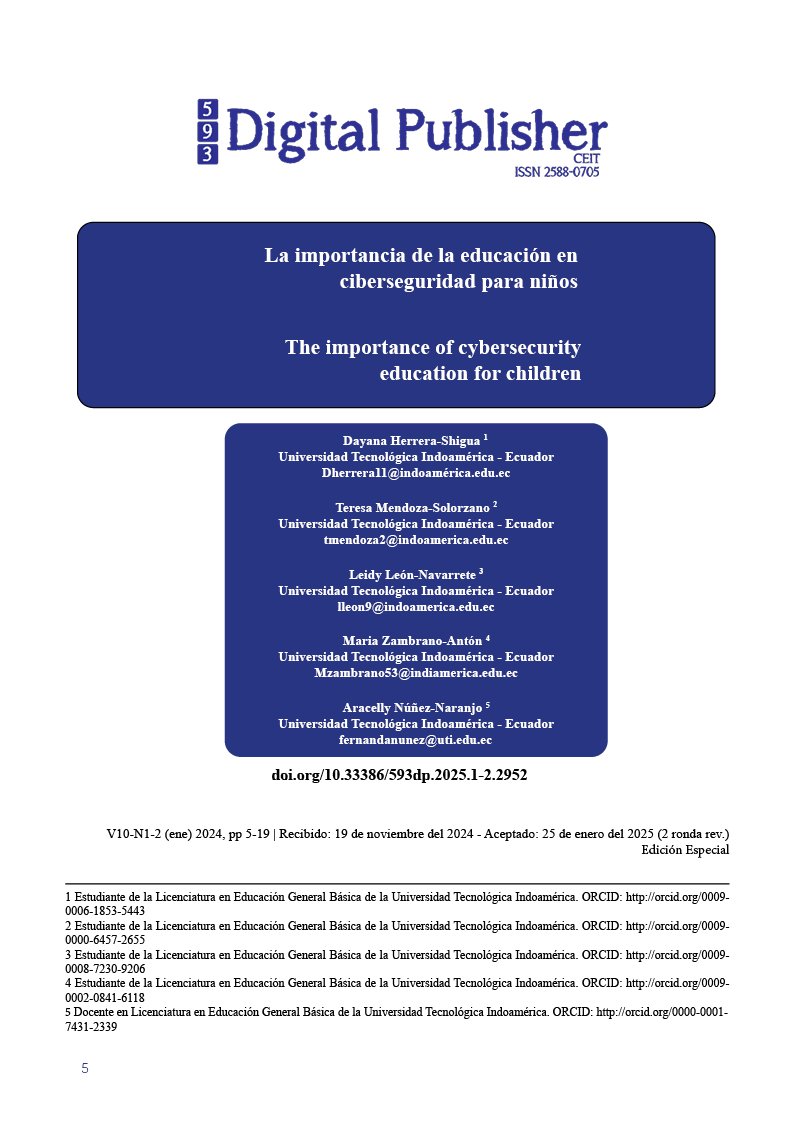The importance of cybersecurity education for children
Main Article Content
Abstract
Introduction: Cybersecurity is a critical issue due to the increasing use of digital devices by children. They often access the Internet without proper supervision, exposing them to threats such as cyberbullying and data theft. Objective: The study aims to analyze the risks children face online and propose educational and regulatory strategies to ensure their safety in the digital environment. Methodology: A systematic literature review and content analysis were conducted to identify key variables related to cybersecurity education, cultural diversity, and the development of digital skills. Results: The findings indicate that early cybersecurity education fosters critical skills in children, enabling them to recognize and manage online risks. Moreover, the study highlights the importance of collaboration among educational institutions, families, and governments to create a secure environment. Conclusion: Child cybersecurity requires a comprehensive approach that combines education, supervision, and public policies. Protecting children in the digital environment is not only essential for their immediate safety but also for empowering them as responsible digital citizens in the future.
Downloads
Article Details

This work is licensed under a Creative Commons Attribution-NonCommercial-ShareAlike 4.0 International License.
1. Derechos de autor
Las obras que se publican en 593 Digital Publisher CEIT están sujetas a los siguientes términos:
1.1. 593 Digital Publisher CEIT, conserva los derechos patrimoniales (copyright) de las obras publicadas, favorece y permite la reutilización de las mismas bajo la licencia Licencia Creative Commons 4.0 de Reconocimiento-NoComercial-CompartirIgual 4.0, por lo cual se pueden copiar, usar, difundir, transmitir y exponer públicamente, siempre que:
1.1.a. Se cite la autoría y fuente original de su publicación (revista, editorial, URL).
1.1.b. No se usen para fines comerciales u onerosos.
1.1.c. Se mencione la existencia y especificaciones de esta licencia de uso.
References
Aguilar Antonio, J. M. (2021). Retos y oportunidades en materia de ciberseguridad de América Latina frente al contexto global de ciberamenazas a la seguridad nacional y política exterior. Estudios Internacionales, 53(198), 169. https://doi.org/10.5354/0719-3769.2021.57067
Aznar-Martínez, B., Casarramona-Basany, A., Grané-Morcillo, J., Lorente-De-Sanz, J., Prats-Fernández, M.-À., & Ballester-Brage, L. (2024). Uso responsable de Internet y seguridad digital: revisión sistemática de programas educativos. Estudios Sobre Educación, 125–152. https://doi.org/10.15581/004.47.006
Barbarita Álava Zambrano, K., Eduardo Basurto Vidal, W., Ronaldo Tóala Vera, R., Superior Politécnica Agropecuaria de Manabí, E., & Félix Lopez, M. (2022). Vulnerabilidades En Los Sistemas Informáticos Owasp Top 10: Revisión Bibliográfica Vulnerabilities in Computer Systems Owasp Top 10: Bibliographic Review. Journal Business Science, 3, 1–8.
Beltran Muñoz, A. (2020). Educar y proteger: análisis de la educación en ciberseguridad para combatir la ciberdelincuencia. Journal GEEJ, 7(2). https://doi.org/10.1344/REYD2024.30.44082
Bustillos Ortega, O., Rojas Segura, J., & Murillo Gamboa, J. (2023). Ciberseguridad y desarrollo de habilidades digitales: propuesta de alfabetización digital en edades tempranas. Interfases, 018, 185–205. https://doi.org/10.26439/interfases2023.n018.6626
Catalina García, B., López de Ayala López, M. C., & García Jiménez, A. (2014). The risks faced by adolescents on the Internet: Minors as actors and victims of the dangers of the Internet. Revista Latina de Comunicación Social, 69, 462–485. https://doi.org/10.4185/RLCS-2014-1020
Chérrez, M., Eduardo, W. I., Pesantez, Á., & Fernando I, D. I. (2021). Ciberseguridad en las redes sociales: una revisión teórica Cybersecurity in social media: a theoretical review. Journal Article, 8, 06.
Criollo, E., Flores, C., Flores, C., Santacruz, J., & Ron, M. (2023). Diagnóstico y línea base de los activos de información e infraestructura crítica de ciberseguridad del estado ecuatoriano. Pro Sciences: Revista de Producción, Ciencias e Investigación, 7, 101–119. https://doi.org/10.29018/issn.2588-1000vol7iss49.2023pp101-119
Cruz Lucas, G. I., Delgado Tejena, L. E., Ponce Solorzano, B. R., & Marcillo Merino, M. J. (2022). Riesgos de seguridad de los datos en la web. Journal TechInnovation, 1(2), 43–49. https://doi.org/10.47230/journal.techinnovation.v1.n2.2022.43-49
Domínguez Castillo, J. G., Cisneros Cohernour, E. J., & Quiñonez Pech, S. H. (2019). Vulnerabilidad ante el uso del Internet de niños y jóvenes de comunidades mayahablantes del sureste de México. RIDE Revista Iberoamericana Para La Investigación y El Desarrollo Educativo, 10(19). https://doi.org/10.23913/ride.v10i19.531
Fernández, D. (2019). Formación TIC, características, razón de ser y contenido. 12, 16–27. https://doi.org/10.51302/tce.2019.243
Fernández, M. R., Soria, I. N., Collado-Valero, J., Lavigne-Cervan, R., & Domenech, B. D. (2022). Ciberacoso y Funciones Ejecutivas en niños y adolescentes una revisión sistemática. Revista de Educacion, 2022(397), 67–92.
Garmendia, M., Garitaonandia, C., Mart’inez, G., & Casado, M. A. (2012). Los menores en internet. Usos y seguridad desde una perspectiva europea. Quaderns Del CAC, 38(1), 37–44.
Guerrero-vega, R. N., Revista, E. A., Forenses, C., & Desde, E. (2024). Nuevo paradigma de la investigación : Oportunidades y desafíos del uso de las herramientas de inteligencia artificial para la elaboración y publicación de productos científicos. Revista de Criminología y Ciencias Forenses: Ciencia, Justicia y Sociedad, 3(5), 0–3.
Hernández Prados, M. Á., López Vicent, P., & Gamboa Gil de Sola, G. (2021). Análisis documental sobre los riesgos y las posibilidades de internet para los menores. Pautas educativas dirigidas a familias. Revista Interuniversitaria de Investigación En Tecnología Educativa, 9–22. https://doi.org/10.6018/riite.430341
Herrero-Martín, J., Rodríguez-Merino, C., Valdivielso, R., & Amo, D. (2022). Formación en ciberseguridad y educación. Variables de sensibilidad y cambio en la formación del profesorado. 6–8. https://doi.org/10.4995/inred2022.2022.15855
Macías-Lara, R. A., Boné Andrade, M. F., Quiñonez Angulo, F., Mendoza Loor, J. J., Estupiñan-Troya, G., & Rodríguez Vizuete, J. D. (2022). Frequent cases, criminalization and prevention of computer crimes in Ecuador: a brief systematic review. Sapienza, 3(2), 231–243. https://doi.org/10.51798/sijis.v3i2.324
Martín-Ramallal, P., & Ruiz-Mondaza, M. (2022). Child protection agents and social networks. The TiKToK dilemma. Revista Mediterranea de Comunicacion, 13(1), 31–48. https://doi.org/10.14198/MEDCOM.20776
Medina Pérez, V. H., & Vargas Ipaz, E. F. (2024). Desafíos de la Enseñanza en Línea Durante la Pandemia Desencadenada por Covid-19en la Educación Básica. Revisión Bibliográfica. Ciencia Latina. Revista Científica Multidisciplinar, 8(3). https://doi.org/10.37811/cl_rcm.v8i3.11957
Miranda, R. (2014). La infancia y la adolescencia en la era digital: Nuevos retos para la garantía de sus derechos. Revista Relações Internacionais Do Mundo Atual Unicuritiba, 4(42), 465–489. https://doi.org/10.21902/Revrima.v4i42.6449
Morales-Paredes, P. I., & Medina-Chicaiza, P. (2021). La Provincia De Tungurahua-Ecuador Cybersecurity for Learning Platforms in Higher Education Institutions in Tungurahua Province of Ecuador. Ed, 10(2), 49–75. https://doi.org/10.17993/3ctic.2021.102.49-75
Mosquera Ayala, A. M. (2019). Tendencias investigativas en educación en Colombia: revisión documental. Sophia, 15(1), 1–4. https://doi.org/10.18634/sophiaj.15v.1i.908
Núñez-Naranjo, A., & Chancusig-Toapanta, A. (2022). Technological tools as a trend in secondary education in times of COVID-19: Theoretical review. RISTI - Revista Iberica de Sistemas e Tecnologias de Informacao, 2022(Special Issue E50), 142–154.
Núñez-Naranjo, A. F. (2024). Analysis of the determinant factors in university dropout: a case study of Ecuador. Frontiers in Education, 9(October), 1–14. https://doi.org/10.3389/feduc.2024.1444534
Olivares Ruiz, N. A., Ostos Cruz, C. E., Suárez Jasso, E., & Pale Oropeza, K. D. (2022). Ciberseguridad: Análisis de riesgos en menores de edad en tiempos de pandemia (Caso de Estudio: Teocelo, Veracruz). Interconectando Saberes, 14, 41–53. https://doi.org/10.25009/is.v0i14.2767
Pillajo-García, P., & Avila-Pesantez, D. (2023). Análisis de ciberseguridad en plataformas e-learning: revisión sistemática de la literatura. Revista Perspectiva, 5, 19–20. https://doi.org/10.47187/perspectivas.5.1.179
Pinto, B., Duarte, A., & Dias, P. (2023). La influencia de los YouTubers en los niños (8-12 años): actualidad y marcas. Doxa Comunicación. Revista Interdisciplinar De Estudios De Comunicación Y Ciencias Sociales, 36, 321–340. https://doi.org/10.31921/doxacom.n36a1638
Quirumbay Yagual, D. I., Castillo Yagual, C., & Coronel Suárez, I. (2022). Una revisión del Aprendizaje profundo aplicado a la ciberseguridad. Revista Científica y Tecnológica UPSE, 9(1), 57–65. https://doi.org/10.26423/rctu.v9i1.671
Taco, A. (2022). Dispositivos wearables y los riesgos a la privacidad: Una revisión de la literatura. Interfases, 16, 213–229.
Tatiana, M., Mata, A., & Estrada, U. L. (n.d.). Y NUEVAS TECNOLOGÍAS EN NIÑOS Y RISKS IN THE USE OF SOCIAL NETWORKS AND NEW.
Trejos-Gil, C. A., & Vélez, Y. P. (2023). Cybercrimes with Minors in the Facebook Social Network: Systematic Literature Review. Nuevo Derecho, 19(32), 1–18. https://doi.org/10.25057/2500672X.1493
Trujillo-Torres, J.-M., Rodríguez-Jiménez, C., Alonso-García, S., & Berral-Ortiz, B. (2024). Revisión sistemática de la literatura sobre la seguridad digital en estudiantes de educación superior. Información Tecnológica, 35(4), 1–12. https://doi.org/10.4067/s0718-07642024000400001
Villa Ramírez, J. N., Mesa Méndez, C. M., Garzón Santos, J. L., & Urueña Sanabria, R. (2023). Redes Sociales: Riesgos y desafíos para la comunidad académica de los colegios de la Policía. Revista Logos Ciencia & Tecnología, 15(3), 112–128. https://doi.org/10.22335/rlct.v15i3.1857
Villarroel-molina, R., Guaña-moya, J., Iván, W., & Paredes, S. (2024). Análisis de Vulnerabilidades de Ciberseguridad Mediante Técnicas de Ciencia de Datos. VICTEC, 5(8), 95–104.






